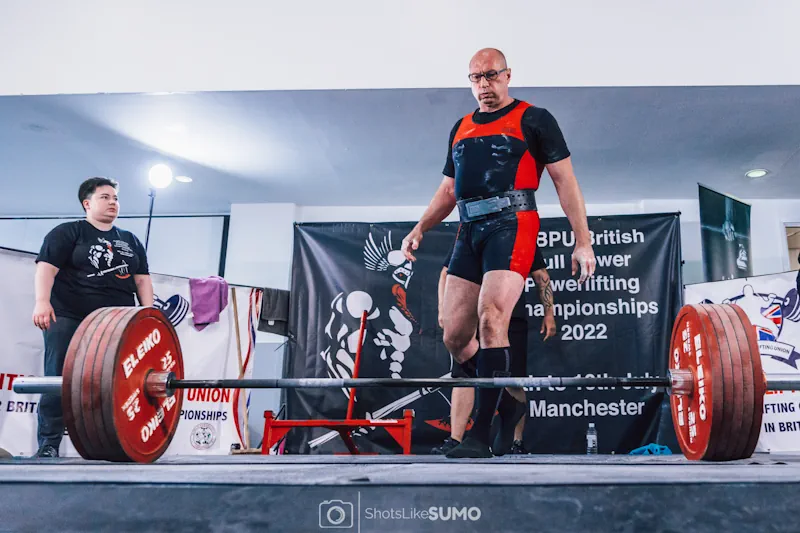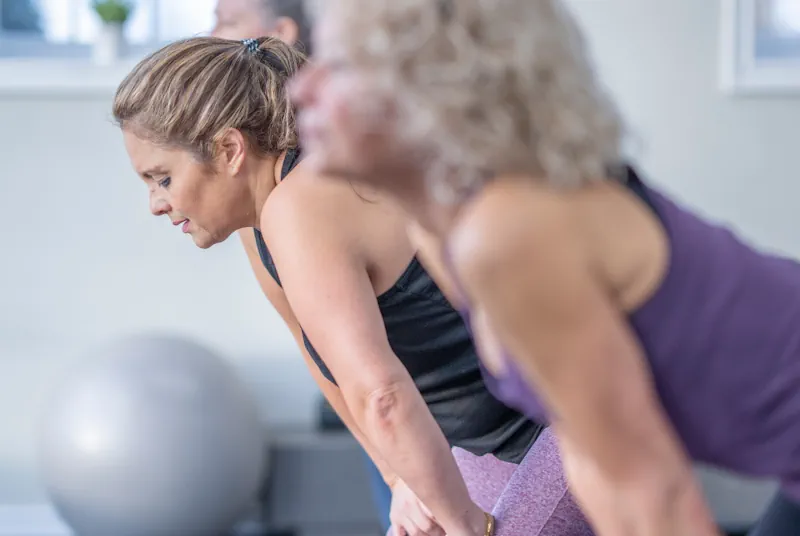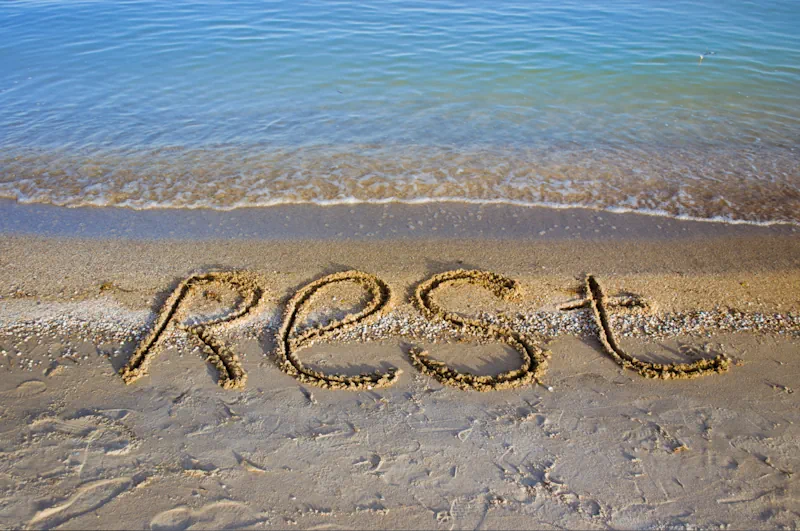Injury Prevention Advice For Masters Powerlifters

What's In This Article
- INTRODUCTION
- UNDERSTANDING THE RISKS
- TAILORED PRE-WORKOUT PREPARATION
- TRAINING MODIFICATIONS FOR OLDER POWERLIFTERS
- ENHANCED RECOVERY AND REST
- REGULAR HEALTH ASSESSMENTS
- LISTENING TO YOUR BODY
- LEVERAGING TECHNOLOGY AND TOOLS
- CONCLUSION
Introduction
Traditionally dominated by younger ages, powerlifting has witnessed a remarkable shift, with a growing number of masters athletes embracing the sport's challenges and rewards. This demographic change brings to the fore the critical importance of injury prevention, particularly as the median age of participants in weightlifting training and competitions rises. Unlike acute injuries often seen in high-impact physical activities like ball sports, powerlifting at older ages presents unique risks, predominantly overuse injuries and those related to prior sports participation.
The phenomenon of older adults participating in weightlifting, notably Olympic weightlifting, isn't merely about physical activity; it's a testament to the evolving nature of sports participation and the recognition of its benefits beyond muscle mass enhancement. However, this shift also necessitates a nuanced understanding of injury risks and how they differ from those typically sustained by weightlifting athletes at younger ages. The emphasis thus lies on lifting and a holistic approach encompassing injury prevention strategies, training-specific nutrition programs, and acknowledging the varied injury locations and rates that could affect older lifters.
This article aims to explore the intricacies of powerlifting for older adults. It will explore how the training habits, physical capabilities, and sports experience before this age influence the nature and frequency of injuries. From sustaining wrist injuries to dealing with common shoulder injuries, our focus will be on providing comprehensive advice that helps older weightlifting enthusiasts - whether they're seasoned field athletes or newcomers to the weight room - train in a manner that is both safe and effective, mitigating the risk of injury while enhancing their overall physical well-being.
Understanding the Risks
In powerlifting for older adults, the injury landscape presents a unique profile, starkly different from that of younger athletes. This divergence is particularly pronounced in the prevalence and nature of injuries sustained. Among masters athletes, a term encompassing those typically over 35, the pivot is towards overuse injuries rather than the acute injuries more commonly seen in younger weightlifting athletes.
Statistically, the incidence of specific injuries, such as shoulder and knee issues, is notable in this demographic. In Olympic weightlifting, for instance, shoulder injury often emerges due to the demands of exercises like the bench press, which place significant stress on the rotator cuff and surrounding structures. Knee injuries, too, are a concern, with the repetitive stress of lifting exacerbating age-related wear and tear.
Age brings about physiological changes that directly impact injury risk in powerlifting. The decline in muscle mass and strength and decreased flexibility and joint mobility are pivotal factors. These changes result in a heightened susceptibility to injuries, particularly in areas like the wrists, which are crucial in weightlifting training. The reduced elasticity of muscles and tendons in older athletes amplifies this risk.
Prior sport participation also plays a critical role in shaping injury risk for older powerlifters. Those with a history in high-impact sports might carry residual weaknesses or vulnerabilities, predisposing them to injuries in their powerlifting endeavours. This history underscores the need to thoroughly assess an athlete's complete physical activity and sports participation background when considering their injury risks.
Injury locations in powerlifting tend to concentrate around the lower back, shoulders, and knees. This pattern reflects the typical movements and stresses involved in the sport. For older athletes, these areas require vigilant monitoring to prevent both acute and overuse injuries.
Additionally, the increasing interest in powerlifting among older adults necessitates training adaptations specific to their physiological needs. These adaptations are crucial not only for injury prevention but also for fostering sport longevity and overall health. This approach is particularly pertinent in mitigating risks like cardiovascular disease, highlighting the broader health benefits of physical activities for older adults in weightlifting training and competition.

Tailored Pre-Workout Preparation
For older powerlifters, the pre-workout preparation phase is critical in minimizing injury risk. Given the physiological changes associated with ageing, such as reduced muscle elasticity and joint mobility, an extended and thorough warm-up becomes beneficial and essential. This preparation serves a dual purpose: it enhances performance and significantly lowers the chances of sustaining injuries.
Specific Dynamic Stretching and Joint Mobilization Techniques:
- Older athletes should focus on dynamic stretching routines that mimic powerlifting movements. This approach helps prepare the muscles and joints specifically for the actions they perform during a training session.
- Joint mobilization exercises are equally important. They involve gentle movements that increase the range of motion, particularly in areas prone to stiffness, like the shoulders, knees, and hips. These exercises aid in lubricating the joints, thereby reducing the risk of injuries such as shoulder and knee issues.
Gentle Cardiovascular Exercises for Enhanced Blood Flow:
- Starting the workout with low-intensity cardiovascular exercises is highly beneficial. Activities like brisk walking, cycling, or using a rowing machine for a short duration can significantly increase blood flow to the muscles.
- Enhanced blood flow ensures that the muscles are well-supplied with oxygen, crucial for preventing muscle strains and other acute injuries sustained during intense physical activities.
Gradual Warm-up Sets Leading Up to Heavy Lifts:
- Implementing a series of warm-up sets before engaging in the main lifting exercises is a strategic approach. These sets should gradually increase in intensity but remain significantly lighter than the primary workout lifts.
- This practice allows the muscles and central nervous system to acclimate to heavier loads, reducing the shock to the system and the risk of injuries like sustaining wrist injuries or muscle tears.
By incorporating these tailored pre-workout strategies, older weightlifting athletes can significantly enhance their readiness for a demanding training session, laying a foundation supporting injury prevention and optimal performance.

Training Modifications for Older Powerlifters
For older powerlifters, the emphasis on adjusting training intensity and volume is critical. This approach ensures a balance between maintaining effective workouts and minimizing injury risk.
Strategies for Reducing Training Volume While Maintaining Effectiveness:
- Opt for quality over quantity by focusing on compound movements that target multiple muscle groups efficiently.
- Use periodization in training. This involves varying the intensity and volume over time, allowing lighter training phases to prevent overuse injuries while maintaining muscle mass and strength.
Importance of Longer Rest Periods and Recovery Time Between Sessions:
- Extended recovery times are crucial for muscle repair and rebuilding in older athletes. Incorporating extended rest periods into training schedules can prevent injuries related to overtraining.
- Emphasize the need for adequate sleep, vital for muscle recovery and maintaining hormonal balance, which is especially critical for the older powerlifting demographic.
Focus on Technique and Controlled Movements Over Maximal Loads:
- Prioritize proper technique and controlled movements rather than lifting maximum weights. This approach reduces stress on joints and muscles, lowering the risk of acute injuries.
- Training should concentrate on form and muscle engagement, ensuring the efficacy of strength-building while protecting against injury.

Enhanced Recovery and Rest
In the context of older powerlifters, the aspect of recovery takes on an amplified significance. As the body ages, its capacity to recuperate from strenuous activities diminishes, necessitating a more robust and thoughtful approach to recovery. This enhanced focus on rest and recovery is not merely a precaution; it's a fundamental component of a sustainable and injury-free powerlifting routine.
Detailed Active Recovery Techniques and Examples:
- Active recovery techniques involve light, non-strenuous physical activities that aid muscle recovery while keeping the body moving. Examples include gentle yoga, which can improve flexibility and reduce muscle stiffness, or leisurely swimming, which offers a low-impact way to engage the muscles without the strain of weightlifting.
- Other techniques like foam rolling can help in muscle relaxation and improve blood circulation, which is crucial for repairing muscle tissues after intense training sessions.
The Critical Role of Quality Sleep in Hormonal Balance and Muscle Repair:
- Quality sleep is paramount for older powerlifters. During sleep, the body undergoes most of its muscle repair and hormonal rebalancing, which are vital for recovery.
- Hormones like growth hormone, which plays a significant role in muscle growth and repair, are predominantly released during deep sleep phases. Thus, ensuring adequate and quality sleep becomes integral to effective recovery.
Structuring Rest Days to Prevent Chronic Injuries and Fatigue:
- Strategically planned rest days are crucial in any training program, more so for older athletes. These rest days are essential to the training regimen, allowing the body to recuperate and prevent chronic injuries.
- Rest days do not necessarily mean complete inactivity. They can be structured to include restorative activities, such as light walks or mobility exercises, which aid in recovery while keeping the body active without the stress of heavy lifting.
Incorporating these aspects of enhanced recovery and rest into the training routine of older powerlifters is not just about injury prevention. It's about enabling these athletes to continue their strength journey with resilience and vitality.

Regular Health Assessments
For older powerlifters, integrating regular health assessments into their training regimen is not just a precautionary measure; it's a vital component of sustaining their athletic performance and overall well-being. Routine medical and physiotherapy check-ups can significantly identify and address issues before they escalate into more severe conditions.
Monitoring for Joint Health and Muscular Imbalances:
- Regular check-ups can help monitor the health of joints, which are often subjected to high stress in powerlifting. These assessments can detect early signs of joint wear or arthritis, which is common in older athletes.
- Evaluations for muscular imbalances are also crucial. Imbalances can lead to undue stress on specific body parts, increasing the risk of injuries. Identifying and correcting these imbalances early can prevent such complications.
Utilizing Physiotherapy for Injury Prevention and Management:
- Physiotherapy sessions are invaluable for injury prevention. They can provide targeted exercises and routines to strengthen vulnerable areas and improve flexibility and mobility.
- In cases where injuries occur, physiotherapy becomes an integral part of the management and rehabilitation process, helping athletes return to training safely and more effectively.
Personalized Program Adjustments Based on Health Assessments:
- The insights gained from regular health assessments should be used to inform and adjust training programs. This personalization ensures that the training regimen aligns with the individual's health and physical capabilities.
- Tailoring the training program can involve exercise selection, intensity, and volume modifications, all aimed at optimizing performance while minimizing injury risk.
By prioritizing regular health assessments, older powerlifters can better understand their physical condition, enabling them to train intelligently and maintain their strength and fitness levels safely.
Listening to Your Body
In the discipline of powerlifting, especially for older athletes, the ability to listen to and interpret the body's signals is a skill of paramount importance. Understanding and responding appropriately to pain and discomfort can differentiate between a successful training session and one that leads to injury.
Differentiating Between Normal Training Fatigue and Potential Injury Pain:
- Powerlifters must distinguish between the typical fatigue following a rigorous training session and the pain that signals a potential injury. While muscle soreness or general tiredness after a workout is regular, sharp or persistent pain, particularly in joints or muscles, should not be ignored.
- Recognizing the type of pain and its source is critical. Training fatigue usually subsides with rest and proper recovery, whereas injury pain tends to persist or worsen with continued activity.
Examples of How Ignoring Body Signals Can Lead to Long-Term Injuries:
- Ignoring initial signs of discomfort can lead to more severe injuries. For instance, if overlooked, a minor shoulder discomfort during the bench press can escalate into a severe shoulder injury requiring extensive rehabilitation or surgical intervention.
- Similarly, continuous training despite wrist pain could lead to chronic issues, hindering training and daily activities.
Promoting Rest or Medical Consultation When Experiencing Unusual Pain:
- Older powerlifters should be encouraged to err on the side of caution. If they experience unusual or persistent pain, it's advisable to rest or seek medical consultation rather than push through the discomfort.
- Early intervention can prevent the development of more severe conditions and ensure a quicker return to training. Consulting a healthcare professional can also provide insights into pain management and preventive strategies tailored to the individual's needs.
By listening to their bodies, older powerlifters can train more effectively, ensuring longevity in the sport while minimizing the risk of injuries.

Leveraging Technology and Tools
In the modern era of powerlifting, especially for older athletes, integrating technology and tools has become invaluable in enhancing training and preventing injuries. These technological advancements offer many benefits, from tracking physical health to providing platforms for community support.
Use of Wearable Devices for Tracking Workouts and Physical Health:
- Wearable devices such as fitness trackers and smartwatches have become increasingly popular among powerlifters. These devices can monitor various aspects of physical health, including heart rate, sleep patterns, and activity levels, providing valuable data that can be used to tailor training sessions.
- For older athletes, these devices can also be instrumental in monitoring recovery metrics, ensuring they are not overexerting themselves and are taking adequate rest.
Apps and Software for Planning and Monitoring Training Progress:
- There are numerous apps and software designed specifically for strength training. These tools allow powerlifters to plan their workouts, set goals, and track their progress over time.
- Many of these applications also offer features like technique analysis and personalized workout recommendations, which can be particularly beneficial for older lifters in optimizing their training while minimizing injury risks.
Online Resources and Forums for Advice and Support:
- The internet is a treasure trove of resources for powerlifters. Online forums and communities provide a platform for older athletes to seek advice, share experiences, and find support from fellow powerlifters and coaches.
- Additionally, numerous websites and online platforms offer educational content, including instructional videos and articles on best practices in powerlifting, which can be crucial for staying informed about safe training techniques and new research in injury prevention.
- Using these technologies and online resources can significantly enhance the training experience for older powerlifters, providing them with the tools and knowledge necessary to train effectively and safely.
Conclusion
In summarizing the key aspects of powerlifting for older adults, it's evident that the journey to maintaining strength and fitness through this sport requires a well-rounded and thoughtful approach. The emphasis on injury prevention and adapting training methods to suit older athletes are central themes in ensuring a safe, enjoyable, and sustainable participation in powerlifting.
Key points include understanding the unique injury risks associated with older lifters and adapting pre-workout routines to include specific dynamic stretching, cardiovascular exercises, and gradual warm-up sets. Training modifications are crucial, focusing on reducing volume while maintaining effectiveness, allowing for extended recovery periods, and prioritizing technique over maximal loads. The role of enhanced recovery and rest cannot be overstated, with active recovery techniques, quality sleep, and structured rest days forming the backbone of injury prevention strategies.
Regular health assessments, listening to the body's signals, and leveraging modern technology and tools further contribute to a comprehensive training regimen. These elements help monitor and enhance physical health and provide platforms for community interaction and support.
As older adults engage in powerlifting, balancing enthusiasm with caution is paramount. By adopting a comprehensive approach to training that encompasses physical preparation, injury awareness, and recovery, older powerlifters can enjoy the manifold benefits of this sport while minimizing the risk of injuries. The goal is not just about lifting weights; it's about uplifting health, well-being, and quality of life, making powerlifting a rewarding endeavour at any age.